[Editor’s note: Place names in this piece are in quotation marks to honour the style of the source publication, IndigiNews. Content note: This piece contains graphic depictions of human remains.]
It started with an email. When I opened it, I was sitting in the living room of my family’s acreage on Treaty 6 territory, utterly unaware of the journey I was about to embark upon. The contents of this email would set things in motion, things I could not have anticipated. We can never know such things in advance, can we?
It was Christmas Eve in “Saskatchewan,” and I was enjoying a few lazy days before the new year. The email was from Andrew Tran, a data reporter at the Washington Post. He contacted me to inform me about the Post’s searchable human remains database held by the Smithsonian Institution, America’s esteemed national museum and the largest one in the world.
“I see that your publication writes about Cree and other Indigenous news and thought you might be interested in going through the database that we just published,” he wrote.
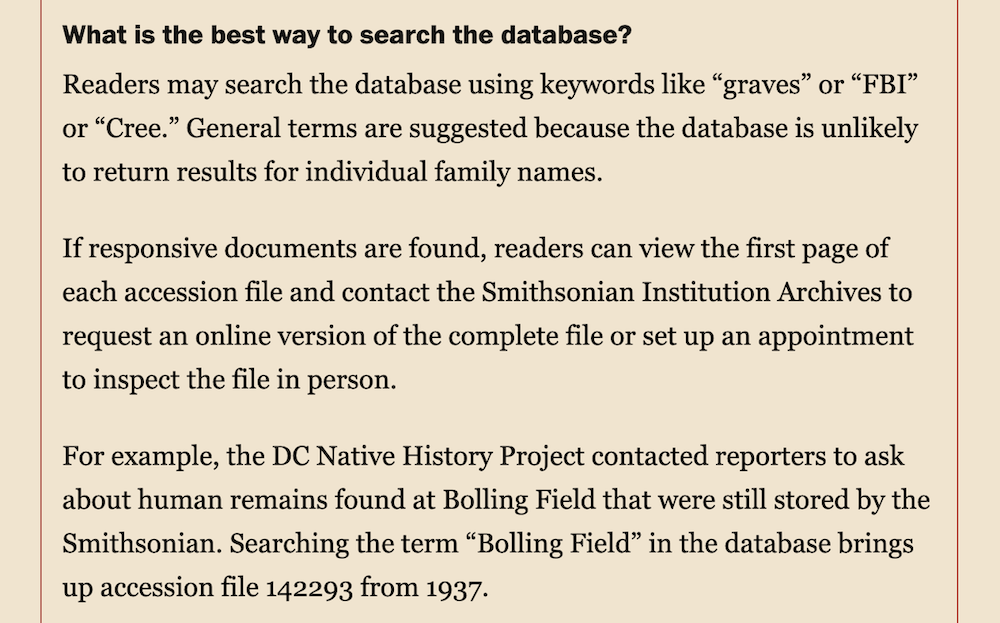
I clicked the link, casually reading the story that contained the searchable database.
I found it odd that the Post used the word “Cree” as an example of a search term one could use in the database because in the 11 years I spent living in the “United States,” very few people I met had ever heard of the Cree. Aside from the Rocky Boy Reservation in “Montana,” most Crees live in “Canada.”
I wondered if Cree people were at the Smithsonian Institution and if that was why Cree was a suggested search term.
It wasn’t until later that night, when I was in bed and struggling to fall asleep, that I searched the database. While my husband slept, I scrolled down the website page until I found the little box that said, “Search the table.”
First, I typed in “Fine Day,” one of my great-great-grandfathers, and nothing came up. Then, I typed in “Little Poplar,” my other great-great-grandfather — and instantly got a hit.
I hadn’t been expecting to actually find anything, and I flinched in the dark as though from a jump scare.
Time stood still
His name was ka-mîtosis, or Little Poplar. He was the grandfather of my grandfather, Alphonse Little Poplar. ka-mîtosis was a member of the warrior society in Chief Sweetgrass’s band of Plains Cree around the time of the Riel Rebellion. A war chief, some folks call him.
War chiefs, sometimes referred to as “sub-chiefs,” were not actually chiefs of the band but would be in charge in times of war (my other great-great-grandfather kamiokisihkwew, or Fine Day, was also a war chief).
I lay there in the dark, staring at Little Poplar’s name in the glow of my phone screen.
My husband, who is a light sleeper, asked, “What is it?”
“They have my ancestor’s remains at the Smithsonian,” I said, but he was already drifting off again.
I clicked the link to the first page of the accession file. (Out of sensitivity, the Washington Post limits each file on its site to the first page. To see the rest of the document, you must contact the Smithsonian.)
Time stood still as I read what appeared.
“1 Box. Skull of ‘Little Poplar,’ Cree Indian Sub Chief from Canada” was written in faint but large, loopy cursive. It was an image of an accession card, the document the Smithsonian filled out when receiving a donation of human remains.
I scrutinized every inch of it. It looked like it had been sent from Fort Assinniboine, Montana, by Dr. C.E. Woodruff on Oct. 2, 1894.
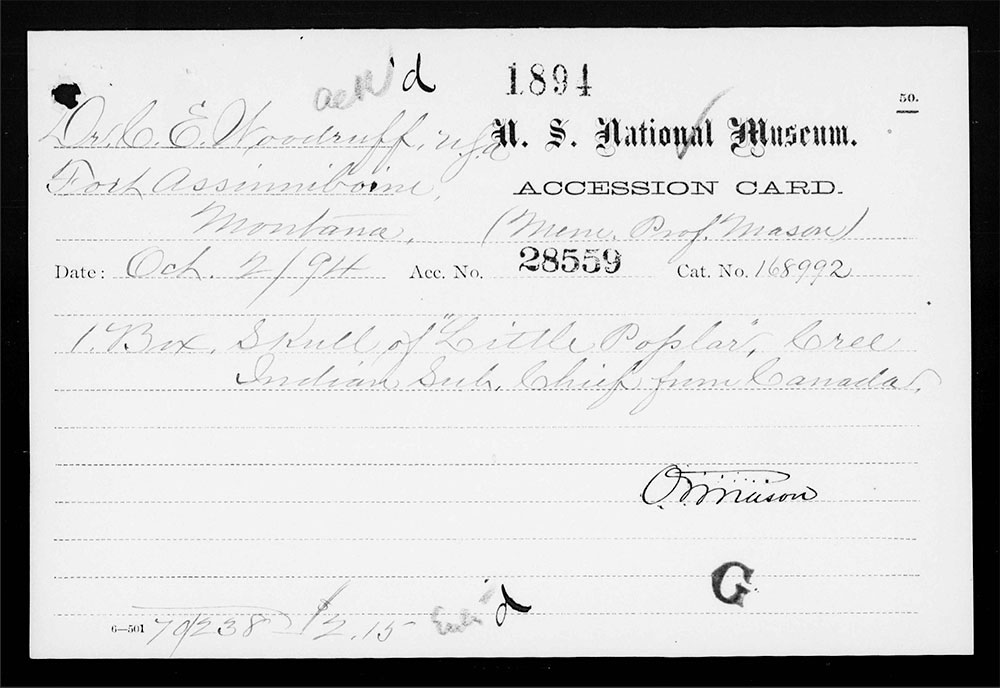
At that time, in the 1880s, our people travelled freely across the U.S.-Canada border. They were there before the border was invented. Before colonization and the creation of “Canada” and the “United States,” “Montana” was just as much our homeland as “Saskatchewan.”
When the Riel Rebellion broke out in “Canada,” some Plains Cree bands travelled south across the border to avoid persecution. Both of my great-great-grandfathers did this, which is why I have some relatives on the Rocky Boy Reservation.
The facts sat like stones in my guts. I tossed and turned in the dark, thinking about how my great-great-grandfather’s skull was in the Smithsonian. It seemed too bizarre to be true. How could my family member be in some institution’s box on a shelf? I felt sick.
I regretted having opened up the email earlier that day. I shouldn’t have searched the database right before sleeping, either. I turned off my phone, closed my eyes and tried to sleep.
But for a long time, I lay in bed, in a state of shock.
In an eerie coincidence, I had just started reading Warrior Girl Unearthed by Angeline Boulley that morning. This novel is about the human remains of Indigenous people in American institutions. The protagonist, a young Anishinaabe woman named Perry Firekeeper-Birch, discovers that the local college has her ancestors in boxes and resolves to get them returned.
I reflected on the parallels between the protagonist in the novel I was reading and my own life.
Like Perry Firekeeper-Birch, I couldn’t understand the depravity that would lead to storing my ancestor’s body parts in a museum. I felt violated somehow. How could something as personal as the remains of a loved one be treated with such disrespect?
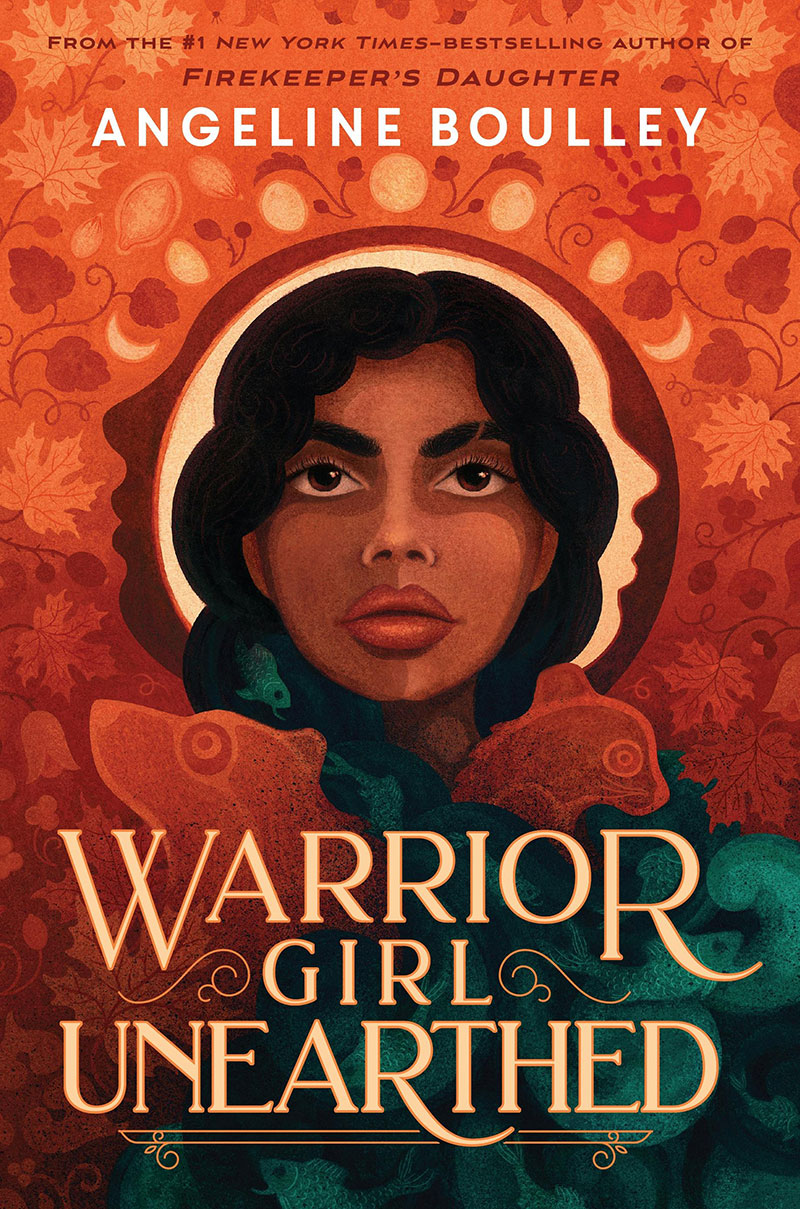
‘All manner of deviltry’
The next day, I awoke with a ball of anxiety in my stomach. It was Christmas, and my kids were excited about their presents, but I found it challenging to be in the moment and enjoy the morning. That pit remained in my stomach for the entirety of the day. Finally, I responded to Mr. Tran’s email to let him know I had found an ancestor in the Post’s database.
“I have seen the documents that mention ‘Little Poplar’ in accession file 028559,” he wrote, “and I have to warn you, the correspondence from the donor is quite horrifying.”
He was not wrong. The dehumanization of Indigenous people — and so many others in the world — is horrifying.
I was grateful for Mr. Tran’s warning. He was able to send me the rest of the documents in the file, which meant I could skip the step of having to contact the Smithsonian myself.
Still, I was unprepared for what I read. Like someone recounting a trauma, I found myself laughing at the egregious wording of the letter. But it wasn’t actually funny — dissociation and deflection are common reactions to traumatic incidents.
“I send you by express for the Smithsonian an Indian skull and I think you have none like it, and it may be of value to your section,” wrote the donor, Charles Woodruff, to the curator of the Smithsonian in 1894.
“It is the skull of Little Poplar,” he continued, “a Cree sub-chief from Canada. He took advantage of the Riel rebellion to attack settlers, robbing, stealing, violating women, torturing victims and doing all forms of deviltry.”
It was the “all manner of deviltry” bit that made me laugh out loud.
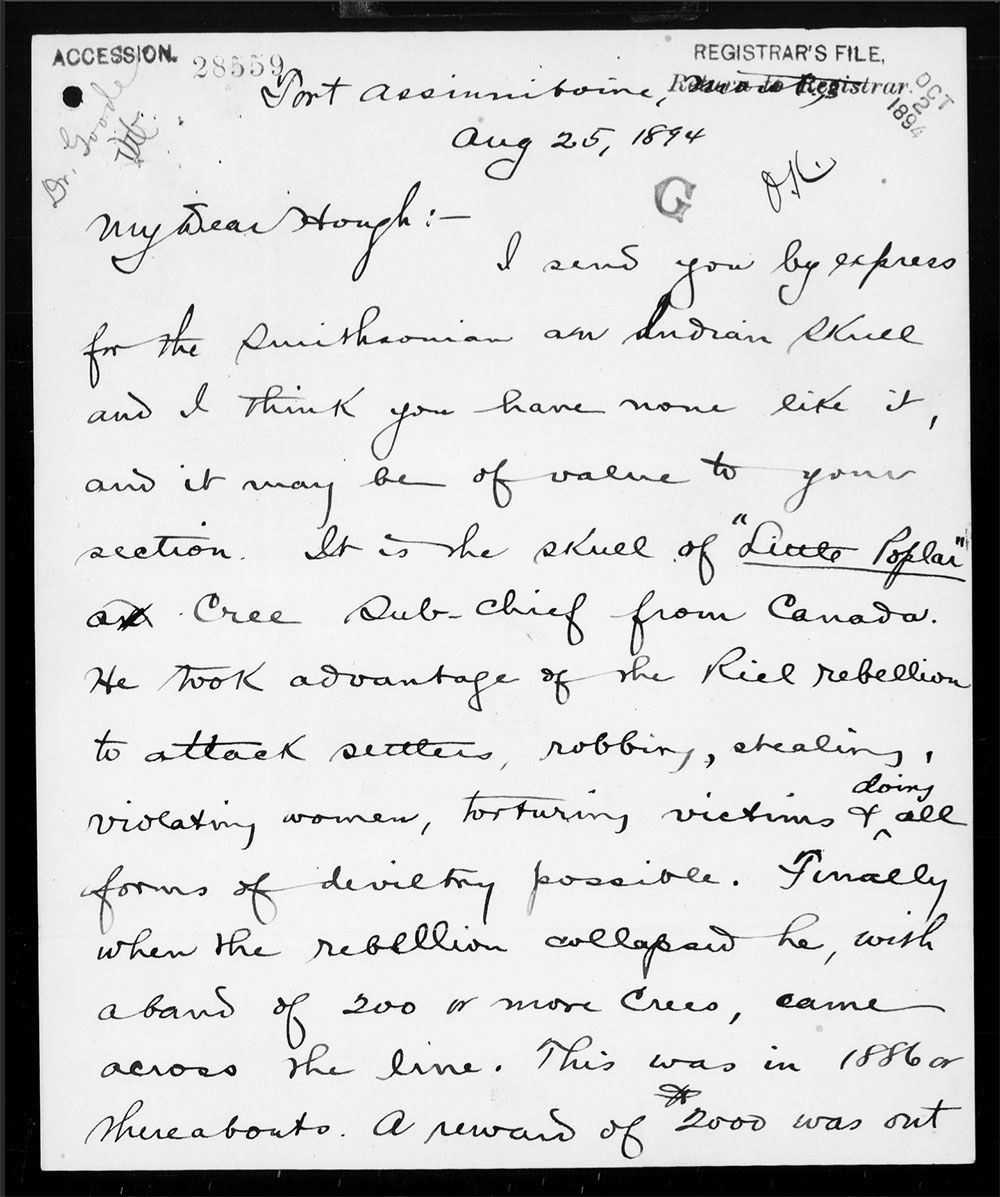
Coming from the pen of a man who had just dug up my great-great-grandfather’s grave, this seems almost like a compliment.
Dr. Woodruff’s letter continues, stating that my ancestor had a bounty on his head of $2,000.
“In August 1886 he was murdered right here in this post by a half breed,” writes Woodruff, referring to Fort Assinniboine, Montana, a U.S. military fort at the time.
He details how a soldier had “watched the grave for several years and when the flesh was all off he took the skull out and kept it as a relic.”
After that, he writes how he went to the grave with the soldier to collect “a few odds and ends” from my great-great mosôm’s grave.
My mind was reeling. It was all too much. There was a bounty on his head? I never knew any of this history of my family. What an incredible story. What a horrifying turn of events.
I knew I had to talk to my family about it, but I feared it would upset them. It turns out I needn’t have worried. When I asked my aunty about it, she was nonplussed. “We knew he was in some museum somewhere,” she told me. “I also heard they have the clothes he was shot in.”
The histories we carry
Hearing my aunty’s words reminded me of the knowledge we still hold in our families. We have an oral tradition, which is a legitimate form of knowledge-keeping. Our relatives have safeguarded the histories of our people for hundreds of years. I’m humbled when I consider the knowledge held by my family members. I’m so grateful they protected such important information about who I am — my lineage.
I have inherited more than intergenerational trauma. I have been given stories passed down from generation to generation for thousands of years. That’s why my aunty knows about our ancestor who died in 1886. That’s how I found out he was shot.
I didn’t know these things about my family as a child — I learned them later, as a teenager and adult, after reconnecting with my family on the Sweetgrass First Nation in so-called Saskatchewan at the age of 14.
Over the years, after spending time there visiting with family, I had the opportunity to hear our family history the way it was meant to be told — through oral transmission.
I found it overwhelming that my ancestry was so well-regarded. Could I ever live up to that? I was just a short, poor, lost young woman who didn’t really know who she was or what she was doing in her life.
“We’re literally Indian princesses,” my cousin Irene said to me a few years ago. I laughed. I know she was being sarcastic, but I understand what she was referring to: the respected positions that my great-great-grandfathers held in their communities. It is an honour to be related to them.
And, of course, the same applies to my great-grandmothers — who I know less about because of how the archivists of the day favoured men and left women out of many records. It would be remiss not to mention them. I wish I had the opportunity to learn about them as well.
Not just a right, but a responsibility
The next person I called was my dad. I was excited to tell him what I had learned and wanted his advice about whether I should try to arrange a visit to the Smithsonian. In some ways, I needed my family’s permission to proceed with this endeavour because they were closer lineal descendants than I was. More importantly, they were my Elders and knew more than I did.
“You see, Little Poplar was affiliated with Âyimisîs,” my dad told me on that call.
“And Âyimisîs was the son of Big Bear. So, they were the northern branch of Treaty 6 Cree. And Âyimisîs was the head of the warrior society there, and Little Poplar was his cohort.”
When I told him I would be in “New York” at the end of February and, therefore, close to “Washington,” I mentioned that I was considering contacting the Smithsonian about visiting the remains. I wondered aloud whether I had the right to do so.
“Oh, absolutely,” he said. “It’s not just a right, but a responsibility.”
His words were revelatory to me. I had never considered my visiting Little Poplar’s remains a responsibility, but as soon as he spoke those words, I felt it. There is still so much for me to learn.
“Those bones need ceremony,” he said, “and ceremony isn’t going to do itself.”
I discussed the rest of Woodruff’s letter and asked, “Why would he take the soles of Little Poplar’s moccasins?” Woodruff had mentioned that the soles of Little Poplar’s moccasins were one of the “odds and ends” he had taken from the grave.
“Well,” my dad said, “funeral moccasins would have had beaded soles.”
Ah, right. That made sense. Since the person won’t be walking on them, the soles could be decorated too.
Long after his death, my ancestor continues to teach me about my culture.
Visiting the Smithsonian
I was nervous when I emailed the Smithsonian. Although I had been told by the reporters at the Washington Post that lineal descendants receive the highest priority concerning human remains at the Smithsonian, I still felt like an impostor as I composed my email.
I worried I wasn’t in close enough relation. Was I really the appropriate person to be making this request? Should someone else in the family be doing this, someone more used to representing the family in this type of situation?
But it was me who was going to be close to “Washington” and could potentially visit. It was me the Washington Post had reached out to. And I was just as qualified as anyone in my family to visit this relative. I tried to let go of my doubts.
In the email, I laid out my case with my usual candour. I explained who I was and my relationship with Little Poplar. I wrote of the obligation I had to bring medicines to this relative and say prayers. I asked if I could have access to him.
I assumed the Smithsonian Institution would be a bureaucratic nightmare to try to navigate. I didn’t know if they would respond or, if they did, how long it would take.
I don’t know about you, but I’ve always found large institutions daunting to deal with. The bureaucratic processes that came with colonization have been alienating to a lot of Indigenous people. We’ve had to get used to the fact that the words we speak are basically meaningless without a piece of paper to back it up — a paper that comes from the very government that destroyed our way of life in the first place.
Imagine my surprise when, the next morning, my phone rang. The name that flashed on my phone was Dorothy Lippert, the Smithsonian’s repatriation program manager.
My heart raced when I answered the call, but Ms. Lippert was gracious and kind. She seemed to be just as excited to be talking to me as I was to be speaking with her. She told me the Smithsonian would accommodate my desire to visit with my relative. And more than that — they would pay for my transportation there and put me in a hotel while I was in the city. After all of my agonizing, it was so simple and easy.
So, I headed to the Smithsonian this month. I never imagined being in a position to say these words, but here we are.
I look forward to being a good relative and honouring my mosôm. I give thanks to the Grandmothers and Grandfathers for putting me in this position as I set out on this sacred journey. I will bring him gifts of medicine, pray for him and give thanks for the gift he gave me — my family. After all, like my dad said, those bones need ceremony, and ceremony isn’t going to do itself. ![]()
Read more: Indigenous, Rights + Justice


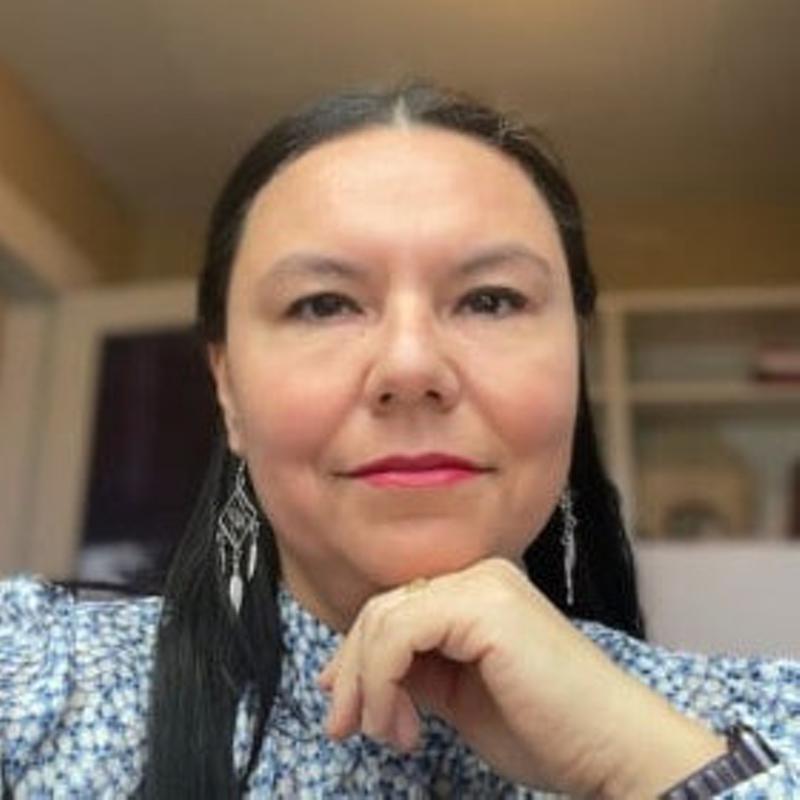

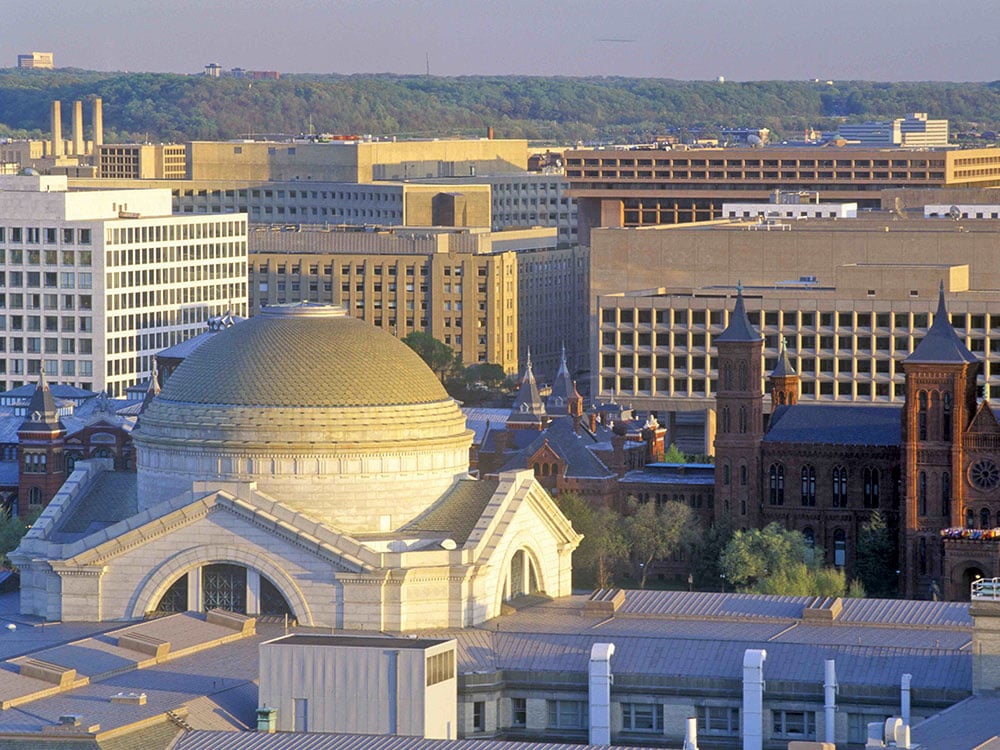












Tyee Commenting Guidelines
Comments that violate guidelines risk being deleted, and violations may result in a temporary or permanent user ban. Maintain the spirit of good conversation to stay in the discussion and be patient with moderators. Comments are reviewed regularly but not in real time.
Do:
Do not: